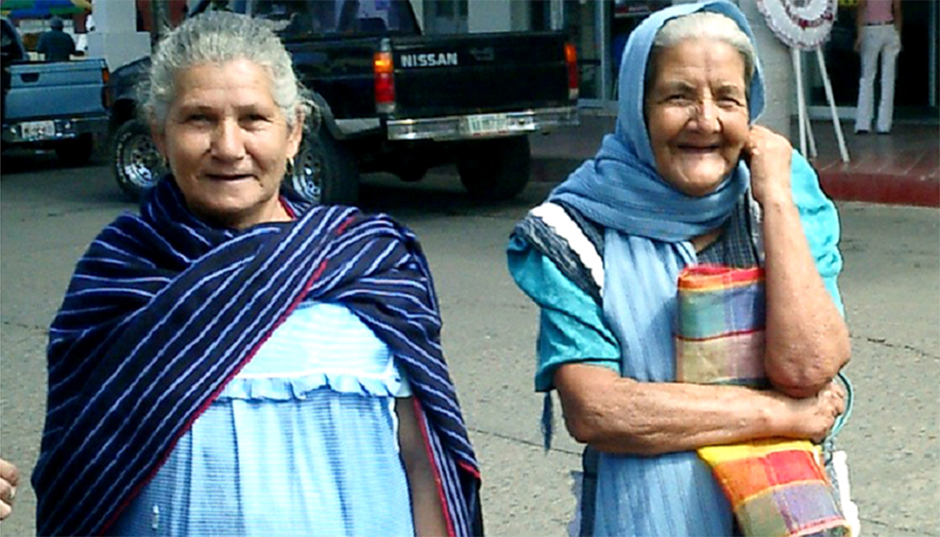Mexican Mosaic

Mexican Viejas
The Mexican Mosaics have primarily focused on migrant labor and newly settling Latino Communities in Adams County, Pennsylvania, just south of Carlisle. Beginning in 1998 and continuing in 2003, our team worked with communities in Pennsylvania as well as in Peribán and Michoacán, Mexico-- communities that lie on opposite ends of the continent, but remain connected through family, work and circular migration. The study expanded in 2011 to include interpreting Spanish for the health professionals in health clinics and working with migrant education.
2011 Mexican Mosaic
The Mexican Migration and Apple Mosaic is the third in a series of Mexican Mosaics focusing on migrant labor and the apple industry in Adams County, Pennsylvania. Coursework for the Mosaic includes SPAN 239 Spanish for the Health Professions with Professor Asuncion Arned0-Aldrich, AMST 200 Introduction to Latino Studies with Professor Laura Grappo, HIST 314 Latino Immigration with Professor Marcelo Borges, and HIST/SOC 313 Fieldwork Practicum with Professor Susan Rose and Professor Marcelo Borges. Eleven students participate in varying numbers of the offered courses, and present on a final research project of their choice at the end of the semester.
Previous Mexican Mosaics
The 1998 Mexican Mosaic focused on migrant labor in Adams County, Pennsylvania, just South of Carlisle. The 2003 Mexican Migration Mosaic worked with communities in Adams County, Pennsylvania and Peribán in Michoacán, Mexico–communities which lie on opposite ends of the continent, but stand closely connected through family, work and circular migration. Through intensive fieldwork and internships, students came to better understand the economy and culture, living and labor conditions, and lives of people in both regions. Students had the opportunity to pick apples in the Adams County orchards, visit migrant worker camps, teach ESL in school classes and after-school programs, intern in migrant Head start programs and day care centers, work with health clinics, and interview growers and advocacy groups in Adams County. In Peribán, students were involved in ethnographic fieldwork and interviewing families of migrant workers and people who have settled in Adams County. Both were full-semester Mosaics involving 18 and 23 students respectively taking 4 courses with either 2 – 3 faculty. (Faculty 1998, Anthropology and American Studies; 2001, Anthropology, History,and Sociology; coursework counted in Latin American Studies, Spanish, History, Anthropology, Sociology, and American Studies).
History of Dickinson's Mexican Mosaic
Introduction to Adams County: Adams County has long been a productive fruit growing region of the United States. Local growers of apples, peaches, pears, and other orchard fruits have historically depended upon migrant laborers to cheaply and efficiently harvest their crops. Over the past fifty years of fruit farming in Adams County, and evolution of migrant labor has taken place. It began with African Americans from Southerns states but as these individuals found more solid employment a switch was made to migrants mainly from Puerto Rico. In recent years, the laborers have come from outside the United States, migrating north from Mexico and some even from Guatemala, Haiti, and the Carribean. Many of these individuals have now settled permanently in small Adams County communities such as Aspers, Biglerville, and York Springs. Through the establishment of Mexican-American communities in Adams County, new levels of linguistic, racial, religious, and cultural diversity have been introduced to the community.
Benefits of Mosaic to Student Research: A unique opportunity was provided for students interested in learning about ethnicity and multi-culturalism in the United States. The Mosaic explores how immigration, gender, race, and ethnicity intersect with economic status, social class, land ownership, and the exploitation of labor. Unlike California, Texas, New Mexico, Arizona, or other regions well known as destinations for immigrants from Latin America, Pennsylvania does not share a border with Mexico, was never a part of the Mexican Republic, and has no large Spanish speaking or Native American population. Adams County does not have a long history of relations between Anglo-Americans and Mexican-Americans. Dickinson students participating in the American Mosaic semester had the opportunity to see a new ethnic community in the process of negotiating its place within the established Anglo culture of South Central Pennsylvania.
What did we do? Dickinson students worked in internships that provide social services to agricultural workers. Examples of such internships were Adams County Head Start, Human Services (which provided G.E.D. and English as a second language courses), Rural Opportunities (food, childcare, job assistance, & educational services), health centers, and others. Through these internships, students had an opportunity to extend their education beyond the classroom, gain experience working with diverse populations, and participate in field research. In addition, students learned about the insights and perspectives of a population that does work essential to our daily lives, but who are invisible to much of the U.S. population. The internships allow students to observe many aspects of workers' lives, but also allows students give back to the communities in which they live. Students were required to keep a daily journal, attend their internship about 20 hours a week and conduct two types of research projects; one ethnographic and one based on the oral histories of Hispanics or human services employees. Topics students chose ranged from education to religion and can be found in greater detail on this site. At the end of the semester, a public exhibit was presented at Dickinson with a sound documentary (including narratives of students and workers) and poster board displays. The exhibit then traveled to other destinations in Adams County so that the research of this community could be shared with all.